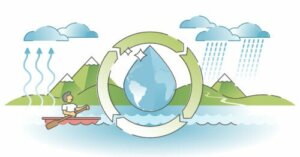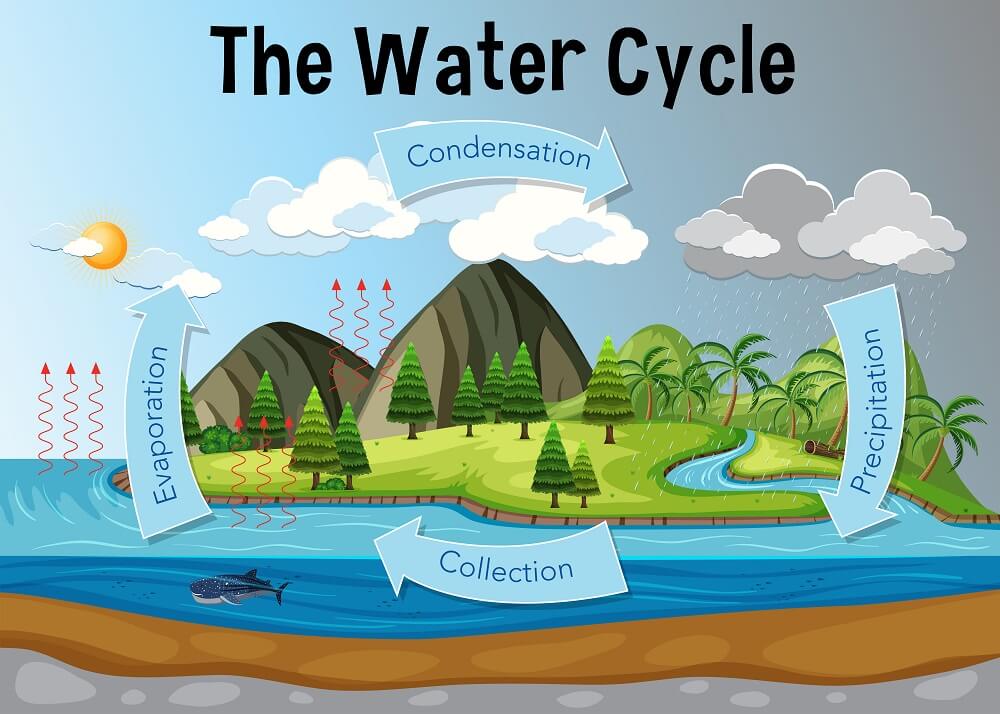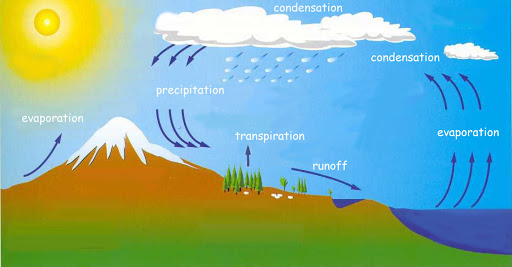How to Explain the Water Cycle to Children

Water is one of the elements that cause most curiosity in children. Where does it come from? Why is the sea so big? Why does it rain? These are frequent questions that we can use to explain the water cycle to children in simple terms.
The key to helping children understand the concept of water, which is quite abstract, is to relate it to things from everyday life. In other words, things that are familiar to them. Let’s start by defining the different “forms of water.”
The water cycle and its different states
Water is a changing but constant element. The water cycle is the continuous change of state by which the amount of water on the planet remains the same over millions of years. In this constant cycle, water can pass through the following states:

- Liquid: This form is the most common and familiar. Here you can start to explain the water cycle to children. The examples are easy and everyday. Why? Because we see and touch water in its liquid state when we bathe, when we get wet from the rain, or when we drink it. It can also be seen in rivers and seas.
- Solid: When liquid water reaches a temperature below 32°F, it freezes. The ways that children can see water in a solid state are ice and snow.
- Gas: In this state, we can see water in clouds, fog, and water vapor. When you take a very hot bath or boil a pot of water, you can see water vapor forming and settling on different surfaces.
Changes in the state of the water
Once children understand the differences and characteristics of the three states of water, it’s time to teach them how the element passes from one state to another. To do this, you’ll need to define some specific concepts:
- When water passes from a solid to a liquid state, the process is called fusion. For example, if you leave an ice cube at room temperature, it slowly melts and becomes liquid water.
- If you freeze it again, the change from liquid to solid is called solidification.
- The change from a liquid to a gaseous state is called evaporation. Water evaporates when it’s heated to high temperatures and forms water vapor. In nature, the evaporation of water from rivers and seas forms clouds, which is the accumulation of millions of water particles.
- In the opposite sense, when water in a gaseous state becomes liquid, we say that it condenses. This happens when the vapor touches a cold surface, for example, when the bathroom mirrors “fog” when you take a shower or when the gaseous water in the clouds suffers a great drop in temperature and condenses to fall as rain.
Explaining the water cycle to children
Once we’ve defined the basic concepts of the state of water and what its different transformations are called, we can address the issue of the water cycle in nature. We’re going to start with evaporation, but we could explain it from any point in the circuit, because it’s a constant cycle.
The energy of the sun is the great driving force behind the water cycle. Solar heat reaches our planet and raises the temperature of the surface, both of the earth and of the water in rivers, seas, oceans, and lakes. The water is then transformed into steam. Even ice is affected by the heat and goes into a liquid state and also evaporates. Living things also contribute to sweat and perspiration.
When water turns into vapor, it becomes light, rises in the air, and forms clouds. Millions of particles accumulate there, clumping together. When the clouds become dense and the air temperature drops, the water condenses and falls as rain, hail, or snow.
Thus, the precipitation returns the water to the land, whether it’s in the sea, a river or a mountain, depending on the differences in temperature, winds, geographical relief, etc. And the cycle begins again…
“We forget that the water cycle and the cycle of life are one and the same.”
– Jacques Y. Cousteau, sailor and researcher –

Is water a renewable resource?
It’s clear that water changes its state and the cycle continues constantly, which is why water’s said to be a renewable resource. However, we need to take care of it and use it responsibly, as its quantity is finite and not so abundant, especially drinking water, which is water suitable for human consumption.
In this sense, both at home and at school we can work together to take care of water with the following actions:
- Don’t leave the tap on when you brush your teeth.
- Fix leaky faucets.
- Take a quick shower instead of an immersion bath.
- Don’t play with water.
Explaining the water cycle to children is simple, as you can relate it to many everyday activities. And if you talk about caring for the planet while you do, you’ll be certain to get their attention.
Water is one of the elements that cause most curiosity in children. Where does it come from? Why is the sea so big? Why does it rain? These are frequent questions that we can use to explain the water cycle to children in simple terms.
The key to helping children understand the concept of water, which is quite abstract, is to relate it to things from everyday life. In other words, things that are familiar to them. Let’s start by defining the different “forms of water.”
The water cycle and its different states
Water is a changing but constant element. The water cycle is the continuous change of state by which the amount of water on the planet remains the same over millions of years. In this constant cycle, water can pass through the following states:

- Liquid: This form is the most common and familiar. Here you can start to explain the water cycle to children. The examples are easy and everyday. Why? Because we see and touch water in its liquid state when we bathe, when we get wet from the rain, or when we drink it. It can also be seen in rivers and seas.
- Solid: When liquid water reaches a temperature below 32°F, it freezes. The ways that children can see water in a solid state are ice and snow.
- Gas: In this state, we can see water in clouds, fog, and water vapor. When you take a very hot bath or boil a pot of water, you can see water vapor forming and settling on different surfaces.
Changes in the state of the water
Once children understand the differences and characteristics of the three states of water, it’s time to teach them how the element passes from one state to another. To do this, you’ll need to define some specific concepts:
- When water passes from a solid to a liquid state, the process is called fusion. For example, if you leave an ice cube at room temperature, it slowly melts and becomes liquid water.
- If you freeze it again, the change from liquid to solid is called solidification.
- The change from a liquid to a gaseous state is called evaporation. Water evaporates when it’s heated to high temperatures and forms water vapor. In nature, the evaporation of water from rivers and seas forms clouds, which is the accumulation of millions of water particles.
- In the opposite sense, when water in a gaseous state becomes liquid, we say that it condenses. This happens when the vapor touches a cold surface, for example, when the bathroom mirrors “fog” when you take a shower or when the gaseous water in the clouds suffers a great drop in temperature and condenses to fall as rain.
Explaining the water cycle to children
Once we’ve defined the basic concepts of the state of water and what its different transformations are called, we can address the issue of the water cycle in nature. We’re going to start with evaporation, but we could explain it from any point in the circuit, because it’s a constant cycle.
The energy of the sun is the great driving force behind the water cycle. Solar heat reaches our planet and raises the temperature of the surface, both of the earth and of the water in rivers, seas, oceans, and lakes. The water is then transformed into steam. Even ice is affected by the heat and goes into a liquid state and also evaporates. Living things also contribute to sweat and perspiration.
When water turns into vapor, it becomes light, rises in the air, and forms clouds. Millions of particles accumulate there, clumping together. When the clouds become dense and the air temperature drops, the water condenses and falls as rain, hail, or snow.
Thus, the precipitation returns the water to the land, whether it’s in the sea, a river or a mountain, depending on the differences in temperature, winds, geographical relief, etc. And the cycle begins again…
“We forget that the water cycle and the cycle of life are one and the same.”
– Jacques Y. Cousteau, sailor and researcher –

Is water a renewable resource?
It’s clear that water changes its state and the cycle continues constantly, which is why water’s said to be a renewable resource. However, we need to take care of it and use it responsibly, as its quantity is finite and not so abundant, especially drinking water, which is water suitable for human consumption.
In this sense, both at home and at school we can work together to take care of water with the following actions:
- Don’t leave the tap on when you brush your teeth.
- Fix leaky faucets.
- Take a quick shower instead of an immersion bath.
- Don’t play with water.
Explaining the water cycle to children is simple, as you can relate it to many everyday activities. And if you talk about caring for the planet while you do, you’ll be certain to get their attention.
All cited sources were thoroughly reviewed by our team to ensure their quality, reliability, currency, and validity. The bibliography of this article was considered reliable and of academic or scientific accuracy.
- SERVICIO DE GEOLOGIA DE LOS ESTADOS UNIDOS: https://www.usgs.gov/special-topic/water-science-school/science/water-cycle?qt-science_center_objects=0#qt-science_center_objects
- https://prd-wret.s3.us-west-2.amazonaws.com/assets/palladium/production/atoms/files/WaterCycleKids_print.pdf
- ASOCIACION ESPAÑOLA DE CLIMATOLOGIA: http://aeclim.org/wp-content/uploads/2016/01/Cambio_global.pdf
This text is provided for informational purposes only and does not replace consultation with a professional. If in doubt, consult your specialist.








